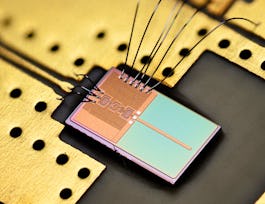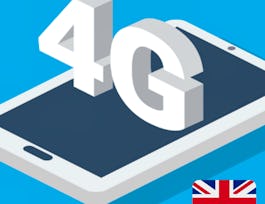This course will provide an introduction and history of cellular communication systems that have changed our lives during the recent four decades and will become an essential and inseparable part of human life. The principles of wireless communication theory are covered with emphasis on the essential concept delivery to non-major learners in the easiest way. Then, it will be covered how such principles are realized and how multimedia services can be delivered in practical LTE cellular systems by which learners are connected and enjoys together in their lives.


Wireless Communications for Everybody
Taught in English
Some content may not be translated
59,800 already enrolled
(2,413 reviews)
Details to know

Add to your LinkedIn profile
12 quizzes
See how employees at top companies are mastering in-demand skills


Earn a career certificate
Add this credential to your LinkedIn profile, resume, or CV
Share it on social media and in your performance review

There are 6 modules in this course
In this part of the course, we will learn the introduction and history of cellular communication system. First, we will take a example of cellular communication system with cell phone. And then, learn about the what a cellular system is and how it has been developed so far. Lastly, we will briefly look into the concepts of future cellular systems.
What's included
5 videos2 quizzes2 discussion prompts
In this part of the course, we will learn the fundamental principles of wireless communication theory. I will raise five fundamental questions in the first lecture as follows: i) 'how can we represent information into a binary format?', ii) 'how can information be transferred?', iii) 'how does wireless digital MODEM work?', iv) 'how can high-rate data be delivered reliably?', and v) 'how can many users access simultaneously?'. During the following 5 lectures, you will have the answers.
What's included
6 videos2 quizzes2 discussion prompts
In this part of the course, we will discuss the basic concept of wireless resource management. I will raise six interesting questions as follows: i) 'how does the interference affect the capacity of wireless networks?', ii) 'why does the cellular system look like as of today?', iii) 'Increasing the number of cells increases the capacity?', iv) 'how is 5G cellular being shaped?', v) 'how does the interference management increase the capacity?' and Ⅵ) 'how does scheduling increase the average capacity?'.
What's included
6 videos2 quizzes2 discussion prompts
In this part of the course, we will learn how multiple antennas can be efficiently used in different strategies for communication system enhancement. First, we look in to the basics of antenna, and then learn about the three main gains that are achievable by multiple antennas: array, diversity, and spatial multiplexing. Lastly, we briefly look in to the concepts of single-user MIMO and multi-user MIMO.
What's included
5 videos2 quizzes2 discussion prompts
In this part of the course, we will learn how the fundamental principles of wireless communication theory, resource management, and multiple antenna technology are implemented in the LTE system.
What's included
3 videos2 quizzes3 discussion prompts
In this course, we will discuss LTE cellular networks.
What's included
5 videos2 quizzes2 discussion prompts
Instructors



Offered by
Recommended if you're interested in Electrical Engineering

Eindhoven University of Technology

Institut Mines-Télécom

Google Cloud
Why people choose Coursera for their career




Learner reviews
Showing 3 of 2413
2,413 reviews
- 5 stars
73.65%
- 4 stars
21.04%
- 3 stars
4.14%
- 2 stars
0.62%
- 1 star
0.53%

Open new doors with Coursera Plus
Unlimited access to 7,000+ world-class courses, hands-on projects, and job-ready certificate programs - all included in your subscription
Advance your career with an online degree
Earn a degree from world-class universities - 100% online
Join over 3,400 global companies that choose Coursera for Business
Upskill your employees to excel in the digital economy
Frequently asked questions
Access to lectures and assignments depends on your type of enrollment. If you take a course in audit mode, you will be able to see most course materials for free. To access graded assignments and to earn a Certificate, you will need to purchase the Certificate experience, during or after your audit. If you don't see the audit option:
The course may not offer an audit option. You can try a Free Trial instead, or apply for Financial Aid.
The course may offer 'Full Course, No Certificate' instead. This option lets you see all course materials, submit required assessments, and get a final grade. This also means that you will not be able to purchase a Certificate experience.
When you purchase a Certificate you get access to all course materials, including graded assignments. Upon completing the course, your electronic Certificate will be added to your Accomplishments page - from there, you can print your Certificate or add it to your LinkedIn profile. If you only want to read and view the course content, you can audit the course for free.
You will be eligible for a full refund until two weeks after your payment date, or (for courses that have just launched) until two weeks after the first session of the course begins, whichever is later. You cannot receive a refund once you’ve earned a Course Certificate, even if you complete the course within the two-week refund period. See our full refund policy.





